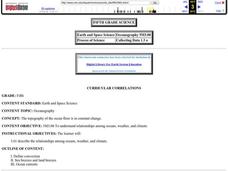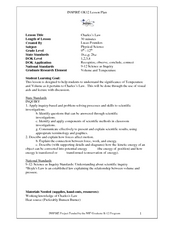Curated OER
Window Treatments for Energy Savings
Students investigate energy-saving window treatments. In this environmental lesson, students research how energy-saving windows work by conducting an experiment using a thermometer and graphing data. Students identify why energy-saving...
Curated OER
Temperature Scales
Eighth graders explore how to read a thermometer. They convert temperature between Celsius, Fahrenheit and Kelvin. Students explain that Celsius is used in the Scientific community and Fahrenheit is used basically only in the United...
Curated OER
Review For Weather Quiz 2
In this science worksheet, students look at the information carefully in preparation for a formal assessment. The focus is upon defining different aspects of air masses.
Curated OER
Power: Work and Energy
Students explore how work and energy create power. They complete activities involving simple machines, energy, energy conversion, and the role of conductors and insulators. They choose from a menu of options the activities they would...
Curated OER
When You're Hot, You're Hot!
Eighth graders examine the development of the different temperature scales. They experiment with hot and cold temperatures.
Curated OER
Curricular Correlations
Here is a terrific way to teach your oceanographers about the effects that the ocean have on the weather and climate found throughout the world. In it, pupils engage in a science experiment designed to emulate how the ocean affects...
Curated OER
Energy Efficient Buildings
Seventh graders create plans for an energy efficient addition to the school. They work in small groups with each group having responsibility for examining one aspect of the problem. They create working diagrams and a model of their...
Curated OER
Plate Tectonics
Students research separate elements of the theory of Plate Tectonics, then share that information with each other, drawing conclusions from the culminated information.
Curated OER
The Composition of Soil
In this composition of soil worksheet, students study the make-up of soil by identifying the amount of air in the soil, the amount of water in the soil, the size of the mineral grains in the soil and the proportion of humus in the soil....
Curated OER
Olympic Solar Energy
Students use cardboard and aluminum foil to construct a solar oven that concentrates enough sunlight to cook a hotdog. They review the history and use of solar energy in relation to the Olympics.
Curated OER
Coffee Cooling
Pupils explore the factors that affect how long coffee stays hot. They develop a question and a testable hypothesis for one factor such as initial temperature or size of opening of the container. Then they design and conduct an...
Curated OER
Earthquake Epicenters and Magnitudes
Students work on a virtual earthquake to increase their understanding of seismograms, earthquake epicenters, Richter Magnitude and triangulation when finding the epicenter of an earthquake.
Curated OER
Charles’s Law
Students describe the relationship between temperature and volume. In this chemistry lesson, students perform an experiment and record their their results. They use Charles' law to explain their observations.
Curated OER
Alternative Energy
Students identify the five major alternative energy sources. In this physical science lesson plan, students assess the advantages and disadvantages for each type of energy. They complete a concept map using information they researched.
Curated OER
Electrical Circuits And Switches
Learners design and draw circuits with batteries, small light bulbs and common household conductors. They build and test the circuit then modify it so someone who couldn't use their hands could turn the circuit on and off.
Curated OER
Sea Ice Research
Students study sea ice and its importance in climate and climate change. They discuss sea ice as a presence of a food source for marine animals in the arctic and complete a lab activity. After completing the lab, they watch a video...
Texas Education Agency
Texas Gateway: Heat and Heat Transfer Methods: Glossary
This is a glossary of terms and definitions used in Chapter 14: Heat and Heat Transfer Methods from the AP Physics online text.
Texas Education Agency
Texas Gateway: Heat and Heat Transfer Methods: Problems & Exercises
This is a list of 82 problems/exercises to solve based on the content of Chapter 14: Heat and Heat Transfer Methods from the AP Physics online text.
Texas Education Agency
Texas Gateway: Heat and Heat Transfer Methods: Conceptual Questions
This is a list of 26 questions covering the major concepts presented in Chapter 14: Heat and Heat Transfer Methods from the AP Physics online text.
Texas Education Agency
Texas Gateway: Heat and Heat Transfer Methods: Convection
By the end of this section, you will be able to discuss the method of heat transfer by convection.
OpenStax
Open Stax: Heat Transfer Methods
In this section of the textbook, learn about the methods of heat transfer: conduction, convection, and radiation. Book can be downloaded.
Texas Education Agency
Texas Gateway: Heat and Heat Transfer Methods: Summary
This page provides a summary of each section of Chapter 14: Heat and Heat Transfer Methods from the AP Physics online text.
Texas Education Agency
Texas Gateway: Heat Transfer Methods
By the end of this section, you will be able to discuss the different methods of heat transfer: Conduction, Convection, and Radiation.
Wisc-Online
Wisc Online: Heat Transfer
Provided here is an extremely useful learning module that helps students explore three major methods of heat transfer. It also provides them with practice identifying each one.























